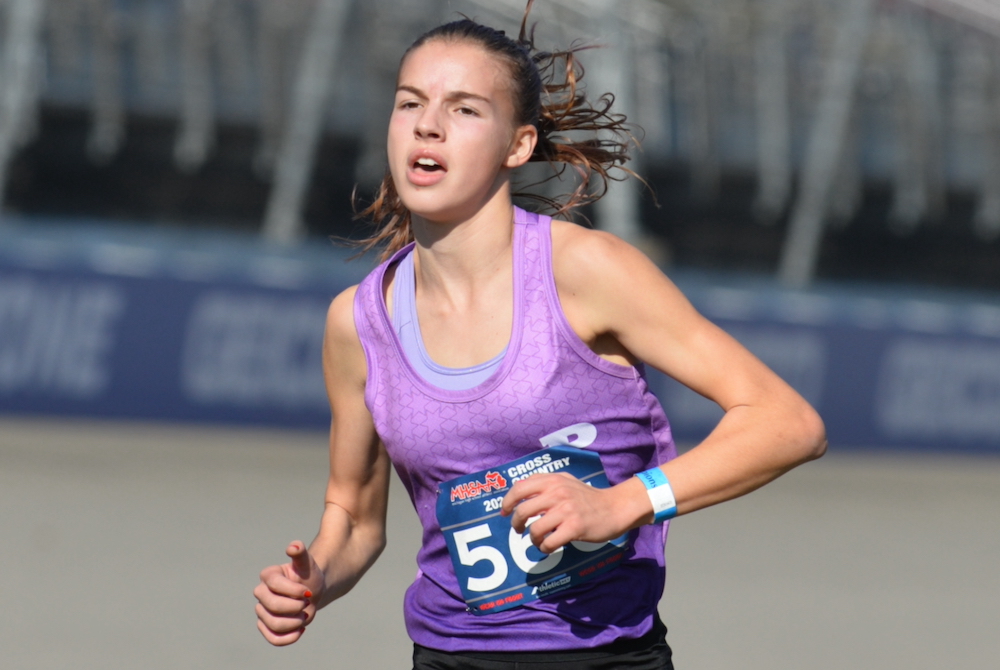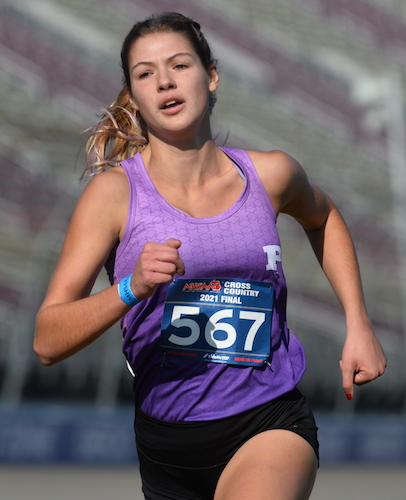
Forsyth Sisters Pace Pioneer in Division 1 Championship Sweep
November 6, 2021
BROOKLYN — If there is an expectation to maintain a family legacy, Rachel Forsyth doesn’t feel it at home.
“My dad makes it very known there’s no pressure put on any of us, but it does feel really good to follow in my sisters’ footsteps,” Forsyth said.
Forsyth is carving out her own legacy at Pioneer, becoming the first of three talented sisters to win an MHSAA cross country championship after crossing the Lower Peninsula Division 1 finish line first Saturday at Michigan International Speedway in 17:09.32.
Her time was the fastest by a sophomore girl in 26 MHSAA Finals at MIS, breaking the mark of 17:17.5 set by Waterford Mott’s Shannon Osika in 2008.
The Forsyth parents, Ian and Jessica, were standout runners for the University of Michigan.
Anne Forsyth was the 2016 Division 1 runner-up and placed fifth at the Foot Locker National Cross Country Championships. Sarah Forsyth, a senior on this year’s team, placed eighth in 18:02.86 Saturday for her third all-state finish.
 The sisters led Pioneer to a third straight Division 1 team championship by a 68-100 margin over Holland West Ottawa.
The sisters led Pioneer to a third straight Division 1 team championship by a 68-100 margin over Holland West Ottawa.
Senior Cookie Baugh was 12th in 18:16.55, junior Emily Cooper 35th in 18:44.39 and sophomore Natalie Mello 45th in 18:54.67 to complete the Pioneers’ scoring.
“My teammates are really fast,” Rachel Forsyth said. “They definitely push me in workouts. We all work together. I love all of them, so it’s a nice atmosphere.”
It was the second time that Forsyth had crossed the finish line first at MIS, but she places an asterisk on last year’s first-place performance.
The MHSAA Finals were split into two sections last year to reduce the size of fields as a COVID-19 precaution. Forsyth won the heat for runners whose teams finished first or second at Regionals, but Birmingham Seaholm senior Audrey DaDamio had the fastest time of the day in the other heat.
“I like ‘won’ the race, but there were two,” Forsyth said. “I feel accomplished right now.”
Forsyth ran fearlessly, going to the lead right away to provide a target for some strong runners. Forsyth reached the mile mark in 5:27.9, with Arianne Olson of Holland West Ottawa (5:28.1) and Julia Flynn of Traverse City Central (5:29.6) the only runners within 10 seconds.
By the two-mile mark, which Forsyth hit in 11:00.3, she had an 8.6-second lead over Olson and a 12.1-second cushion over Flynn.
Flynn finished second in 17:20.49, while Olson was third in 17:36.81. The top seven runners broke 18 minutes.
“It’s really special,” Forsyth said. “I watched my sisters run here. It’s just so exciting to be doing it myself.”
PHOTOS (Top) Ann Arbor Pioneer’s Rachel Forsyth pulls away during the closing stretch of Saturday’s Division 1 race at MIS. (Middle) Sarah Forsythe makes her final sprint to finish second for Pioneer. (Click for more from RunMichigan.com.)

MHSAA Vault: MIS Rose to Challenges to Host 2020 LP Finals
By
Rob Kaminski
MHSAA benchmarks editor
November 12, 2021
The “MHSAA Vault” features stories from past publications and other documents in the MHSAA Library. This issue takes a look at the MHSAA Cross Country Finals at Michigan International Speedway, which celebrated 25 years in 2020 – although it was an event that nearly didn’t happen last fall …
In 1996, the MHSAA and Michigan International Speedway began a partnership the changed the course of the Lower Peninsula Cross Country Finals – quite literally.
The land in and around the track at Brooklyn would host the Finals for all classes of runners in one place on one day, an annual festival of nearly 2,000 runners competing for the MHSAA’s top honors.
Even skeptics – and there were several among running purists who thought the course was too flat, for example – can’t deny the results.
Finals attendance nearly doubled in that first year, and crowds in excess of 10,000 have enjoyed a day of racing several times, including a record 12,153 in 2011.
Enthusiastic crowds were the norm in recent years, with 11,232 in 2017, and nearly 11,000 in 2018 (10,989) and 2019 (10,873).
In fact, attendance failed to reach at least 8,000 only twice since the move to MIS.
Of course, last year was an exception, when attendance was limited to 1,000 spectators per session due to the COVID-19 Pandemic. Fans also were restricted to the grandstands rather than following the action throughout locations on the course.
To reduce the number of runners in each race, the event was spread over two days, with each Division being run in two separate “sections” with times then combined at the end to determine team and individual champions.
While not ideal, the end result was another year of fantastic efforts at MIS – both from student-athletes and those behind the scenes.
“Even at the last hour, less than a week ahead of the Finals, we were closer to not having the Finals than we were to having them,” said MHSAA Assistant Director Cody Inglis, who coordinates the cross country postseason. “Rumors and challenges of mandated shutdowns, testing and other requirements were being discussed and caused a lot of unknowns. Even at the Regional level, we had schools, Regional courses and hosts shutting down their facilities; we had to relocate four Regionals 48 hours prior to race times. That scenario just could not happen at the Finals level where far more runners and much more travel would be involved.”
Among the many last-minute hurdles was the edict from NASCAR – which owns MIS – that all persons on site be temperature checked upon entry. That meant securing thermometers that were easy to operate in short order, along with personnel necessary to conduct the readings.
The attendance limitations certainly helped to implement the temperature screening, but brought their own issues.
“Limiting spectators was not a popular decision, but it really was the only way to have a race,” Inglis said. “We were taking direction and working with policies and protocols from the MDHHS, the Governor’s office, Lenawee County Health Department, MIS and NASCAR.”
Part of the solution was to utilize the grandstands as a “barrier” between participants and spectators. The reduced number of fans were dispersed over thousands of seats while still allowing them the chance to watch their student-athletes compete.
“It wasn’t the same, it wasn’t easy or perfect, but it was what we had to do to have a race,” Inglis said. “Separating the Finals into two days and different sections also allowed us to spread out the event and limit the number of people on site at any one time. This was a key part of the plan and worked well even though it separated races within a Division.”
The MHSAA, MIS and the cross country community never lost focus of the main goal: a culmination of the season for the student-athletes, who deserved something last year more than ever. And, more than ever, MIS once again displayed its advantage as a venue that could adapt to the fluid nature of the times to pull off the event.
“There were some thoughts of using four different sites, but as we learned during the Regionals, the climate of things was so tenuous from one area of the state to another that we couldn’t be 100-percent certain that there wouldn’t again be last-minute cancelations,” Inglis said. “MIS was wonderful to work and collaborate with, and was the best option to get it done. It was never mentioned once publicly about the possibility of not having the Finals – only how we could best do it under uncharted conditions.”
The moving parts and ever-changing scenarios created more complexity than ever in finalizing a season, but every decision was made with the complete desire to conduct the Finals as close to normal as possible.
“I firmly believe that a finish to the season, no matter the differences in race formatting and fan experience, was something everyone would have taken when the season began in August,” Inglis said.
Indeed, the finish line in Year 25 at MIS might have been the most gratifying of them all.

